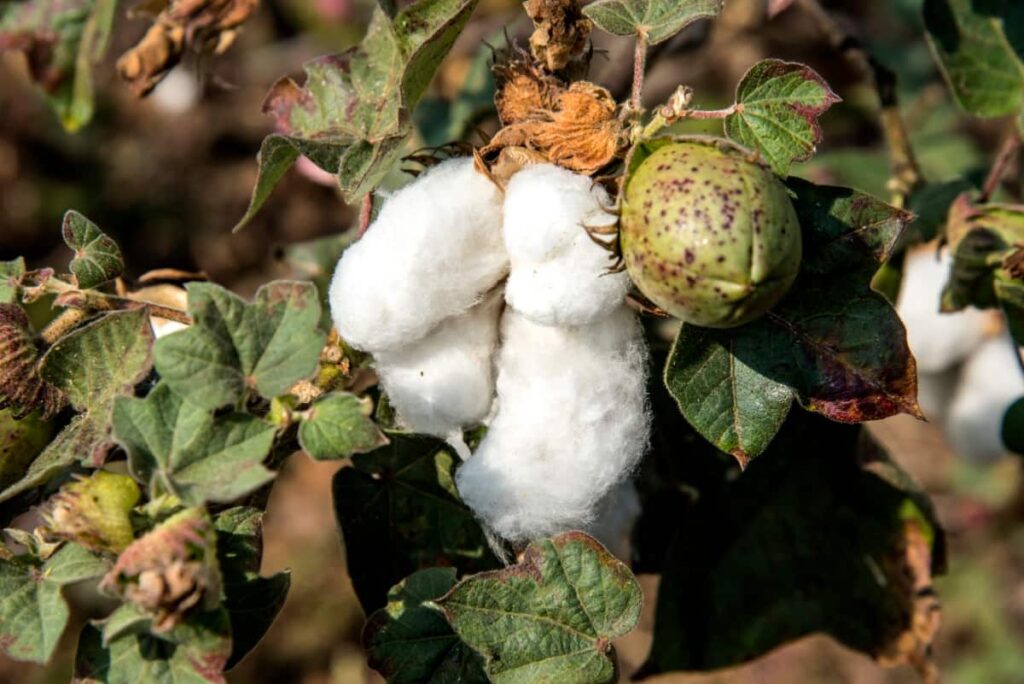Cotton nutrition refers to the essential nutrients required for optimal growth and development of cotton plants (Gossypium spp.). These plants primarily need macronutrients like nitrogen, phosphorus, and potassium, which are vital for plant vigor, flower development, and boll production. Also, cotton requires micronutrients such as iron, zinc, and manganese, which play vital roles in enzyme functions and metabolic processes.
The Importance of Balanced Fertilization in Cotton Production
Balanced fertilization is paramount in efficient cotton nutrient management to ensure optimal plant nutrition and yield. Properly calibrated fertilization practices help maintain soil fertility, promote vigorous plant growth, and enhance yield potential. By supplying the right nutrients in the right amounts at the right times, growers can mitigate nutrient deficiencies, minimize environmental impacts, and achieve sustainable cotton production.

Soil Testing Before Fertilization
The Role of Soil Analysis in Fertilizer Decision Making
Soil analysis is a critical step in developing an effective fertilizer management plan for cotton farming. It provides essential information about soil nutrient levels, pH, and other properties, guiding growers in making informed decisions about fertilizer selection and application rates. By understanding the soil’s nutrient status, farmers can optimize fertilizer use, prevent over-application, and minimize nutrient imbalances, leading to improved crop health and yield.
How to Collect Soil Samples for Cotton Fields
Samples need to be collected from multiple locations within the field, considering factors like type of soil, topography, and historical management practices. Depth-specific sampling is recommended to assess nutrient distribution in the root zone. Proper sampling techniques, including using clean tools and sampling at the appropriate times, ensure reliable results for informed fertilizer management decisions.
Nitrogen Management in Cotton
Determining the Right Nitrogen Rates for Your Cotton Crop
Determining the optimal nitrogen rate for a cotton crop involves considering factors such as soil type, expected yield goals, and previous crop rotations. Soil testing for cotton fields, plant tissue analysis, and nitrogen uptake models can help fine-tune nitrogen recommendations for specific field conditions, ensuring efficient fertilizer use and maximizing yield potential while minimizing environmental impacts.
Timing and Methods of Nitrogen Application: Fertilizer Timing for Cotton Crops
Splitting nitrogen applications throughout the growing season can better match crop demand, reducing losses through leaching or volatilization. Pre-plant, side-dress, and foliar application methods offer flexibility in nitrogen management, allowing growers to adjust fertilizer inputs based on crop growth stage, weather conditions, and other factors.
Phosphorus and Potassium for Healthy Cotton Growth
Identifying Phosphorus and Potassium Requirements
Phosphorus and potassium are vital nutrients for cotton growth, influencing root development, flowering, and overall plant vigor. Soil testing helps determine the availability of these nutrients, with factors such as soil type and pH affecting their uptake by cotton plants. Potassium requirements in cotton involve various physiological processes, including photosynthesis, enzyme activation, water regulation, and nutrient transport.
Potassium and Phosphorus Application Cotton Farming
By taking the results of soil tests and crop nutrient requirements into consideration, growers can tailor application rates and methods accordingly. Incorporating phosphorus and potassium fertilizers during soil preparation or through in-season fertilizer application in cotton helps ensure availability during critical growth stages.
Micronutrients for Cotton Growth
The Importance of Micronutrients in Cotton Production
Micronutrients such as boron, zinc, iron, manganese, copper, and molybdenum are involved in enzyme activation, photosynthesis, nutrient transport, and other vital functions. Deficiencies in these can lead to reduced yield, poor fiber quality, and increased susceptibility to diseases and pests. Therefore, ensuring proper micronutrient availability is essential for maximizing cotton productivity and profitability.
Micronutrient Application Techniques and Timing
Soil testing for cotton fields and plant tissue analysis helps assess micronutrient levels and guide fertilizer decisions. Depending on the micronutrient and its specific requirements, application methods such as soil incorporation, foliar spraying, seed treatment, or fertigation may be employed. Timing of micronutrient application should coincide with critical growth stages, ensuring optimum uptake and utilization by cotton plants for sustained growth, development, and yield.
In case you missed it: Cotton Cultivation Cost Per Acre in India: Exploring State-wise Average Production Cost

Organic Fertilizers in Cotton Agriculture
Benefits of Using Organic Fertilizers in Cotton
Organic fertilizers, made from natural ingredients like vermicompost, manure, and plant residues, provide a slow-release nutrient supply, promoting gradual soil enrichment and improved soil structure. Organic fertilizers in cotton cultivation enhance soil microbial activity, fostering nutrient cycling and organic matter decomposition, which enhances cotton soil fertility optimization and resilience. Organic fertilizers also contribute to reduced nutrient leaching and runoff, minimizing environmental pollution and preserving water quality.
Best Practices for Organic Fertilizer Application
Proper selection and sourcing of organic fertilizers based on nutrient content, quality, and compatibility with soil and crop requirements are essential. Incorporating organic fertilizers into the soil during land preparation or applying them as top dressings during the growing season ensures efficient nutrient distribution and uptake by cotton plants. Timing applications to coincide with periods of peak nutrient demand and favorable weather conditions optimizes nutrient availability and utilization.
Fertilizer Application Techniques
Traditional vs. Modern Fertilizer Application Methods
Traditional fertilizer application methods, such as broadcasting or manual spreading, involve uniform distribution of fertilizers across the field surface. While simple and cost-effective, these methods may result in uneven nutrient distribution, leading to inefficiencies and potential nutrient losses.
In contrast, modern fertilizer application techniques, including precision equipment such as variable rate spreaders and sprayers, enable more precise and targeted nutrient placement. These methods allow growers to adjust fertilizer rates based on soil variability and crop requirements, optimizing nutrient use efficiency and reducing environmental impacts.
Precision Agriculture Technologies in Fertilizer Application
Precision fertilization in cotton by integrating data-driven approaches and advanced machinery. Global Positioning System (GPS) technology, coupled with Geographic Information Systems (GIS), enables accurate mapping of soil variability and prescription mapping of fertilizer rates.
Variable rate application equipment automatically adjusts fertilizer rates based on real-time field data, optimizing nutrient distribution and minimizing waste. Furthermore, remote sensing technologies, such as satellite imagery and drones, provide valuable insights into crop health and nutrient status, facilitating timely fertilizer application decisions.
Managing Fertilizer Use Under Irrigation
Fertilization Strategies for Irrigated Cotton Fields
Pre-plant or pre-irrigation fertilizer applications ensure nutrient availability before crop establishment, while split applications throughout the growing season match nutrient supply with crop demand. Additionally, fertigation—injecting fertilizers through irrigation systems—an integrated nutrient management cotton offers precise nutrient delivery and efficient utilization by cotton plants, maximizing yield potential and minimizing nutrient losses.
Water-Fertilizer Integration for Optimal Cotton Growth
Techniques such as fertigation allow for simultaneous water and fertilizer delivery, promoting uniform nutrient distribution and uptake by cotton plants. Furthermore, adopting irrigation strategies that prioritize water and nutrient conservation, such as deficit irrigation or drip irrigation, can enhance crop water and nutrient use efficiency, supporting sustainable cotton fertilization practices.
In case you missed it: Cotton Cultivation; Planting, Harvesting Guide

Monitoring and Adjusting Fertilization Practices
Assessing Plant Health and Soil Nutrient Levels During Growth
Regular monitoring of plant health and soil nutrient levels is essential for effective fertilizer management throughout the growing season. Visual assessment of plant vigor, leaf color, and growth patterns can indicate nutrient deficiencies or excesses. Additionally, conducting periodic soil testing for cotton fields helps evaluate nutrient availability and identify potential deficiencies or imbalances.
Making Mid-Season Adjustments to Fertilizer Plans
Mid-season adjustments to fertilizer plans allow growers to respond to changing crop needs and environmental conditions. Based on plant and soil assessments, adjustments may involve modifying fertilizer rates, timing, or application methods to optimize nutrient supply and support crop growth. Variable rate technology and precision equipment enable targeted adjustments, allowing growers to address specific areas of the field with varying nutrient requirements.
Sustainability and Environmental Considerations
Reducing Environmental Impact Through Efficient Fertilizer Use
Practices such as soil testing, precision agriculture, and balanced fertilization help optimize nutrient use efficiency and minimize excess nutrient applications. By matching fertilizer rates to crop requirements and using advanced application techniques, growers can reduce nutrient runoff, leaching, and volatilization, mitigating environmental pollution and preserving water quality.
Adopting Sustainable Practices in Cotton Fertilizer Management
Adopting sustainable practices in cotton fertilizer management involves integrating agronomic, economic, and environmental considerations into decision-making processes. This includes optimizing nutrient use efficiency, minimizing waste, and promoting soil health and fertility. Sustainable fertilizer management practices may include the use of organic amendments, cover crops, crop rotations, and integrated nutrient management approaches.
In case you missed it: Pest Management in Cotton Farming: Natural, Biological, and Chemical Control

Conclusion
By understanding crop nutrient requirements, employing precision application techniques, and adopting sustainable practices, growers can optimize nutrient use efficiency, minimize environmental impacts, and enhance overall crop performance. Cotton fertilizer guidelines through careful monitoring, adjustments, and a commitment to sustainability, cotton farmers can achieve higher yields, improved quality, and long-term success in their operations.
- Profitable Village Farming Business Ideas in 2024
- High-Yield Aquaculture: Fast-Growing Fish for Farming
- Effective Fish Pond Construction Techniques for Beginners
- Irrigation and Water Management in Pineapple Farming
- Blossom to Harvest: Mastering Flowering and Pollination in Papaya Farming
- Pig Fattening Essentials: From Selection to Sale for Beginners
- Raising Wagyu Cattle: A Complete Guide for Premium Beef Production
- Soil Types and Their Water Holding Capacity
- Optimizing Irrigation Schedules for Coconut Groves for Enhanced Yield
